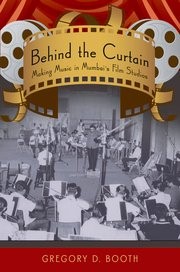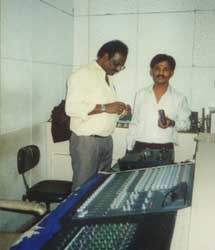The Unsung Heroes of music world
 The music lovers hear to some of the beautiful immortal songs which are of three or three and half minutes, but has anybody thought how much efforts have gone into making of one song? The credit of the song goes to the singer first and then the composer. And, very little or minuscule credit goes to the people who play the background instruments. They are the real unsung heroes who bring life into the songs with the musical instruments like Guitar, Bongo, Bag Pipe, Percussion Pieces, Saxophone, Rudraveena, Ghungroo, Kokirigo, Synthesizer and many more. They give beautiful and soothing interludes to songs which renders more connotations to the songs.
The music lovers hear to some of the beautiful immortal songs which are of three or three and half minutes, but has anybody thought how much efforts have gone into making of one song? The credit of the song goes to the singer first and then the composer. And, very little or minuscule credit goes to the people who play the background instruments. They are the real unsung heroes who bring life into the songs with the musical instruments like Guitar, Bongo, Bag Pipe, Percussion Pieces, Saxophone, Rudraveena, Ghungroo, Kokirigo, Synthesizer and many more. They give beautiful and soothing interludes to songs which renders more connotations to the songs.
The “Bollywood” songs are played all over the globe. Some of them have made the music lovers go crazy and wild. Alam Ara (1931) manifested the beginning of sound in Hindi cinema; from here songs were specially written, composed and sung. With Alam Ara, Hindi cinema became synonymous with ‘all-singing and dancing’ films. People would throng to cinema halls just to watch and hear songs of some cinemas. Songs are remembered long after the films they featured in, whereas the movies are forgotten. The 1950s saw the golden era of film music. Who’s who names started getting associated with the songs; Manna Dey, Rafi, Geeta Dutt, Shamshad Begum, Lata, Asha, Suraiya, Talat, Mukesh, Hemant, Kishore Kumar and, committed music directors, greats like SD Burman, Salil Choudhary, Roshan, Madan Mohan, Naushad, O P Nayyar and Shankar-Jaikishan made the musical world swirl and swing to a verity of genre of songs.
Can you visualize the song “Roop tera Mastana” from film Aradhana without the saxophone interludes, in which sexy Rajesh Khanna woos Shrmila with his bashful glances? Can you imagine “Tum jo mil gaye ho” from film Haste Zakm without the cheery, fast steering background score showing Navin Nischal as a taxi driver driving Priya Rajwansh on a dark night with heavy downpour at the Marine Drive? And, the legendary song “Mein zindagi ka saath nibhata chala gaya” from film Hum Dono with the hero, Dev Anand’s cigarette lighter tune? Like these so many songs are created magically with superb background orchestration.
 There are the great artists Manohari Singh, Kersi Lord, Homi Mullan, Ananda Shankar, Ustad Sabri Khan, Hindraj, Anthony Gonsalves, Burjor Lord, Blasco Monsorate – those who rendered master pieces in the background score of songs. There are such about five hundred other musicians. I am sorry; I am unable to list all of them here. The music world of Hindi cinema which includes the music directors, singers, lyricists and actors should always remain indebted to these unsung heroes for creating magical scores for their blockbusters. These really talented accompanying musicians had a lion’s share in making of thousands of songs.
There are the great artists Manohari Singh, Kersi Lord, Homi Mullan, Ananda Shankar, Ustad Sabri Khan, Hindraj, Anthony Gonsalves, Burjor Lord, Blasco Monsorate – those who rendered master pieces in the background score of songs. There are such about five hundred other musicians. I am sorry; I am unable to list all of them here. The music world of Hindi cinema which includes the music directors, singers, lyricists and actors should always remain indebted to these unsung heroes for creating magical scores for their blockbusters. These really talented accompanying musicians had a lion’s share in making of thousands of songs.
Those days, until 1990s, hours of retakes for pieces of the music from a mixture of musical instruments would be required to record a just a 3-4 minute song. Music studios were as big as warehouses, unlike the one-room apartment spaces of today’s digital studios. There were spaces earmarked for rhythm, string, brass, guitar and mallet sections. They could accommodate about 100-odd musicians.
 The accompanying musicians – a big troop of them would showcase the expertise of their hands and feet, sometimes mouth, the precision of their nimble fingers and wrists to create an immortal song that would mesmerize music lovers for years to come. These musicians built innumerable masterpieces and though they were applauded after the recording of the song, for their contribution, they never got their due credit or recognition for their work. Often these musicians worked on a meager daily wages on hourly basis.
The accompanying musicians – a big troop of them would showcase the expertise of their hands and feet, sometimes mouth, the precision of their nimble fingers and wrists to create an immortal song that would mesmerize music lovers for years to come. These musicians built innumerable masterpieces and though they were applauded after the recording of the song, for their contribution, they never got their due credit or recognition for their work. Often these musicians worked on a meager daily wages on hourly basis.
Do you know the recording of the song was painstaking? 10 musicians would share one mike; each had to create the magic on one mike turn by turn or sometimes simultaneously in synch. Can you imagine what hard work of those artists would go in the brief musical pieces? If one person does the mistake the entire musical piece had to be redone till it excelled; which means the singer also had to sing again and again till the accompanying artists did their role perfectly. The journey was plodding and painful indeed. Those days a song recorded in first take would save money. All recording were live nothing would be in absentia or prerecorded. The irony is that a nation which is so obsessed with the cinema songs never stepped behind the screen to notice these hardworking accompanying musicians. Some of these artists purchased instruments by mortgaging their family gold, land, and houses. They were so drawn to the music that everything else was secondary.
The heavy and bulky instrument – saxophone was one of the favorites of music directors. It requires both brain and brawn to play music. Wind instruments need to be blown. It requires strong lungs power to blow and needs to be controlled well to hit the right note. Mr. Manohari Singh was a saxophonist and was the main controller of great R.D. Burman’s group along with Basudev Chakroborty. Similarly Kersi Lord his brother along with their father introduced influx of Latin-American instruments and Spanish instruments to the Hindi musical world. Instruments like the kokirigo, and other strange-looking things that produced unique and fuzzy sounds.
 Gregory D Booth’s recently published book ‘Behind the Curtain’: Making Music in Mumbai’s Studios. This book faithfully recreates the old, golden age of music. It reveals story of musicians who always remained behind the curtains. It gives an account of music industry from the perspective of the musicians who shaped its history. It accounts a rare insider’s look at the process of musical production from the late 1940s to the mid 1990s, before the advent of digital recording technologies. Booth explains who these unknown musicians were and how they came to join the film music industry. The book is based on fascinating set of first-hand accounts from the musicians themselves; he reveals how the day-to-day circumstances of technology and finance shaped both the songs and the careers of their creator and performers. The book unfolds the technological, cultural, and industrial developments that led to the enormous studio orchestras of the 1960s-90s as well as the factors which eventually led to their downfall in contemporary India. This book is a ‘must read’ for all Hindi cinema music lovers.
Gregory D Booth’s recently published book ‘Behind the Curtain’: Making Music in Mumbai’s Studios. This book faithfully recreates the old, golden age of music. It reveals story of musicians who always remained behind the curtains. It gives an account of music industry from the perspective of the musicians who shaped its history. It accounts a rare insider’s look at the process of musical production from the late 1940s to the mid 1990s, before the advent of digital recording technologies. Booth explains who these unknown musicians were and how they came to join the film music industry. The book is based on fascinating set of first-hand accounts from the musicians themselves; he reveals how the day-to-day circumstances of technology and finance shaped both the songs and the careers of their creator and performers. The book unfolds the technological, cultural, and industrial developments that led to the enormous studio orchestras of the 1960s-90s as well as the factors which eventually led to their downfall in contemporary India. This book is a ‘must read’ for all Hindi cinema music lovers.














































